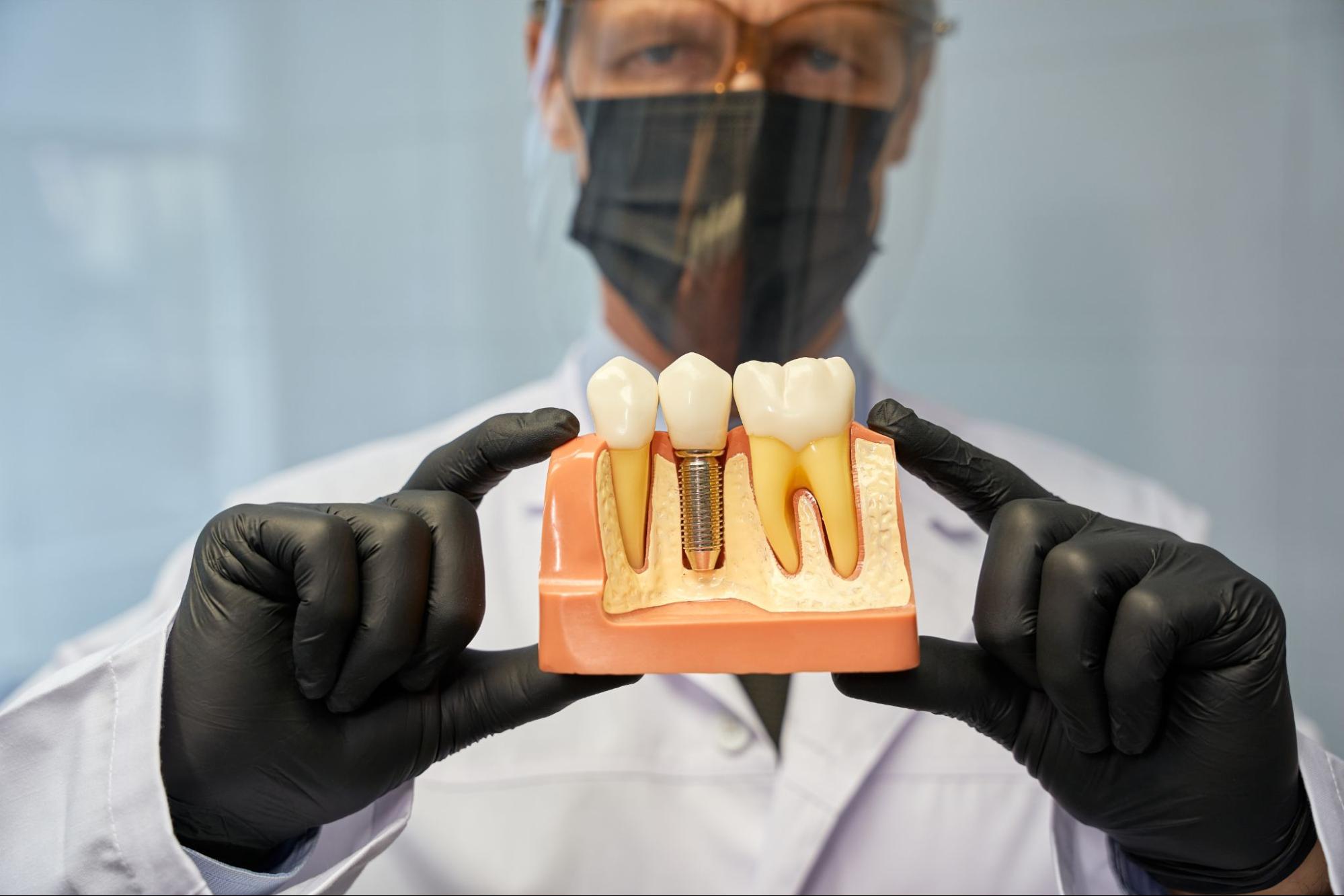Missing teeth can leave you feeling self-conscious. They affect the way you chew, speak, and smile. Over time, gaps also cause the bone to shrink and shift nearby teeth. Living with these problems can take a toll on you. A dental implant provides a sturdy, long-lasting solution that looks and feels natural.
Understanding Dental Implants?
A dental implant is a titanium post that replaces the root of a tooth. Dentists place it in the jawbone, where it fuses with the bone. This process creates a secure crown, bridge, or denture base. Unlike other options, implants don’t rely on nearby teeth for support.
How Does a Dental Implant Work?
A dental implant isn’t just a screw in your jaw. It becomes part of your body over time. This process starts the moment your dentist places the post. Healing takes several months as bone cells grow and surround the implant. That stability is why implants feel and function like natural teeth.
The Science Behind Dental Implants
Dental implants rely on decades of research and development. Scientists have studied how bone heals and responds to different materials. Today, implants are made from titanium and other biocompatible metals that have been proven safe in the body. These materials encourage bone growth and reduce the chance of rejection. Understanding this science helps patients feel confident in their choices.
Materials That Support Healing
Titanium is the most common implant material. It’s strong, lightweight, and naturally resists corrosion. Bone cells readily grow onto titanium’s surface, forming a stable connection without harming tissue. Researchers continue to explore new coatings that improve healing even more.
How Bone Bonds With Implants
The jawbone heals around the implant post over several months. This process, known as osseointegration, enables implants to function like natural roots. Tiny gaps between bone and metal fill in with new bone cells. With proper care, this connection can last for decades. The result is a secure base for chewing and smiling.
Advances in Implant Technology
Modern implants feature surface textures that speed healing. Dentists also use 3D scans to place implants with greater accuracy, thereby reducing complications and improving overall results. Technology also enables implants to work for a greater number of patients. Today’s implants are safer, faster, and more reliable than ever.
Understanding Osseointegration
Osseointegration is the secret to an implant’s strength. Bone cells grow onto the titanium surface of the post, creating a tight bond that prevents movement. With proper care, this bond lasts for decades. You can bite and chew without worrying about slipping.
The Benefits of Dental Implants
Dental implants offer a range of benefits that go beyond just restoring a gap in your smile. They help maintain your oral health and improve your day-to-day life. Additionally, they offer a reliable, natural-feeling solution that supports long-term confidence. Patients often report improved chewing strength, clearer speech, and increased overall comfort.
Enhanced Comfort and Stability
Implants fuse with the bone, creating a stable base. Unlike dentures, they don’t slip or move while eating or speaking. This stability gives you peace of mind in social settings. You don’t need messy adhesives or adjustments. Many people forget they even have implants because they feel so natural.
Long-Term Durability
Dental implants can last many years. With proper care, they often outlast bridges and dentures. You avoid constant repairs and replacements. This long life can save you money and stress over time. They become a dependable part of your daily routine.

Improved Chewing Power
Implants restore nearly full chewing strength. That means you can eat crunchy or tough foods comfortably. Unlike partial dentures, they don’t rely on other teeth for support. It reduces strain on the rest of your mouth. Eating becomes easy and enjoyable again.
Natural Look and Feel
A well-made implant crown blends with your natural teeth. It matches the color, shape, and shine of your smile. Others won’t notice it’s a replacement tooth. The feel and bite also closely mimic a real tooth. Many say they gain confidence quickly once the final crown is in place.
The Step-By-Step Dental Implant Procedure
Getting an implant takes time and planning. It begins with a thorough dental exam and a discussion of your specific needs. Then, the dentist outlines the surgical and healing phases. Each stage builds toward a stable, natural-looking tooth replacement that can last many years:
1. Consultation and Planning
Dentists begin with scans and an exam of your mouth. They check the bone quality and your health history. Then, they explain your options and timeline. This step sets clear expectations and ensures a safe environment. You leave knowing exactly what comes next.
2. Surgery and Healing
Your dentist places the implant post into your jawbone. Next, they close the gum over the implant to allow it to heal. The bone grows around the post over several months. Temporary teeth help you chew during this time. Regular visits confirm progress and comfort.
3. Attaching the Final Tooth
After healing, the dentist uncovers the implant. They place the abutment and then the final crown. This crown blends with your natural teeth in shape and color. You regain full function and a confident smile. The result feels secure and natural.
Who Can Get a Dental Implant?
Not everyone is ready for implants immediately. You need healthy gums and enough bone to hold the post. Additionally, your overall health must support the healing process. Some people require additional steps, such as bone grafting, to build strength. A dentist will guide you through this process.
Bone Density and Health
A strong jawbone is key for implant success. It can’t hold the post if the bone is thin or damaged. Dentists often recommend bone grafts in these cases. It adds time to the process but improves results. A scan shows precisely what you need.

Health Conditions and Risks
Certain conditions raise risks with implants. Diabetes, immune disorders, or heavy smoking can slow healing. Your dentist will carefully review your health history. They might suggest steps to improve healing first. Open communication keeps you safe and informed.
Age Considerations for Implants
Adults of nearly any age can consider implants. Children usually wait until their jaws stop growing. Older adults may still qualify if their bones are healthy and medical conditions are managed. A dental exam helps confirm if implants are right for you. Your dentist can guide you through the best options.
Risks and Considerations of Dental Implants
Every surgery has risks. Implants can fail if the bone doesn’t fuse properly. Infection or nerve issues are rare but possible. Good hygiene and follow-up care lower these risks. Consult your dentist if you experience pain or swelling.
Cost and Investment
Implants cost more upfront than dentures or bridges. However, they often last decades without frequent repairs, which saves money and hassle over time. Many patients see them as a wise, long-term choice. Insurance sometimes covers part of the cost.
Maintenance and Care
Cleaning implants is like caring for natural teeth. You brush, floss, and get regular checkups. Avoiding tobacco and poor habits helps them last longer. Dentists will show you how to clean around the implant. With good care, they stay strong and healthy.
Dental Implants vs. Other Tooth Replacement Options
You have several options for replacing missing teeth. Bridges use nearby teeth for support. Dentures sit on top of the gums. Implants anchor into the bone. Each option has trade-offs in cost, feel, and durability:
Implants vs. Bridges
Bridges can look natural but require grinding healthy teeth, which weakens those teeth over time. Implants leave healthy teeth untouched and last longer in most cases. Many people prefer implants for strength and independence.
Implants vs. Dentures
Dentures are removable and may slip while eating, which can cause sore spots on the gums. Implants feel secure and don’t move. They also help stop bone loss in the jaw. Many patients report that implants feel more like real teeth.
Diet, Nutrition, and Lifestyle Impact on Dental Implants
A strong, healthy body helps dental implants heal and last longer. The foods you eat directly affect bone strength and gum health. Certain habits, like smoking or heavy alcohol use, can slow healing or cause failure. Managing stress also helps the body recover more effectively. Understanding these factors can protect your investment and improve your results.
Nutrients That Support Bone and Gum Health
Calcium and vitamin D help build strong bones around the implant. Protein also supports healing tissue. Fresh fruits and vegetables provide vitamins that keep gums healthy. Avoid sugary snacks that can encourage the growth of harmful bacteria. A balanced diet helps implants last longer.
Habits That Delay Healing
Smoking reduces blood flow to the gums and bone. It raises the risk of infection and implant failure. Excessive alcohol can also weaken the immune system. Stress slows recovery and may lead to grinding or clenching your teeth. Developing good habits and practicing self-care can significantly increase your chances of success.
What is a Dental Implant and Why it is Worth Considering
Your smile holds power beyond appearance. Choosing dental implants isn’t just about filling gaps; it’s about reclaiming the strength and freedom to live confidently daily. If you’ve thought about restoring your teeth, start a conversation with your dental care provider now. Your jaw shifts and weakens every moment you wait, making the path harder. A healthier, stronger smile is closer than you think.
Visit the Meader Family Dentistry blog for trusted dental advice and insights.






